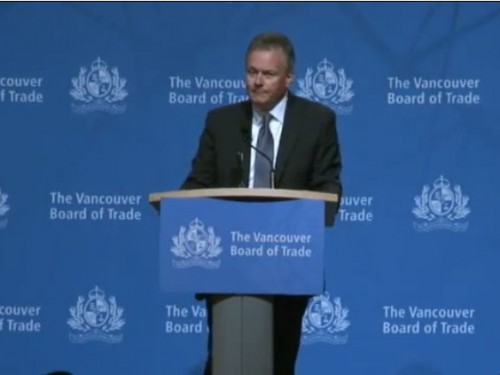Returning to Natural Economic Growth
Introduction
Thank you for that kind introduction and to all of you for coming this morning. It’s my pleasure to be here with the members and guests of the Vancouver Board of Trade.
My focus this morning is the Canadian economy and, in particular, how it will return to natural growth. The story has three parts: Where are we now? Where are we going to end up? And how will we know we are on the right path?
Where We Are Now
I probably don’t need to tell anyone here that the recent global recession was the worst downturn since the Great Depression. In very short order, global GDP fell more than 3 per cent and millions of jobs were lost. In Canada, almost a half million jobs were lost and GDP fell by more than 4 per cent.
The recession in Canada is now history, of course, thanks in large part to timely fiscal and monetary policy measures. We were the first of the G-7 to recover our recessionary decline in output and start expanding anew. We have regained all the jobs lost in the crisis and added almost 600,000 more.
But everyone knows, we are not yet back to normal. Interest rates are at extraordinarily low levels. With unemployment above 7 per cent, there is still slack in the labour market. The export sector, close to 7 per cent below its pre-recession peak, still has a lot of ground to make up.
Firm creation has been lagging…
There’s something else. A characteristic of a naturally growing economy is a steady increase in the population of companies. However, for five years after the start of the crisis, we saw virtually no increase in the population of Canadian companies.
This matters, a lot. Large, established companies certainly provide the foundation of economic growth. As they grow, or become more productive, or generate new ideas, everyone benefits. However, it is the creation of new companies that serves as a natural engine for growth. New ideas, new products and new ways of producing them are often the seeds of new companies. As they grow from one employee, to five, to 20 or more, they generate an outsized proportion of employment - in every economy, not just ours.
New companies create new jobs, which create new incomes, which get spent, creating a virtuous circle of self-sustaining growth. That’s what makes it natural.
Although the data on the population of firms are choppy, in the period from 2008 to 2012, there was almost no net creation of companies in Canada. Particularly hard hit have been Canada’s exporters, which were exposed to the full brunt of the global crisis. Their numbers out-and-out declined in the recession and, based on their ongoing weak output, have likely remained flat since then. The group most profoundly affected has been manufacturing exporters.
… as is broader business investment
Meanwhile, many existing businesses also seem hesitant to make major investments - and no wonder.
Yes, there has been significant capacity added in the mining, oil and gas sectors. We have seen important, long-term investment in such projects as the oil sands, shale gas extraction here in British Columbia, and some mining projects. Indeed, during the recovery, this activity accounted for three-quarters of the contribution to growth made by investment. It helped return the share of overall business investment in GDP to close to historical levels.
However, companies in other sectors have told us that they have held off on creating new capacity until they see more concrete signs of stronger demand. In the meantime, they have focused on small, targeted or niche projects - in other words, getting the most out of their existing capital. Such investments are important. But a more normal, post-recession evolution would show greater investment in the capital stock of firms across most sectors - not just mining, oil and gas.
Confidence in short supply
In our summer Business Outlook Survey, companies told us that uncertainty about the nature and timing of improving growth prospects is weighing on their investment decisions. Much uncertainty centres around U.S. fiscal and monetary policy, the future of Europe’s economy, and the sustainability of growth in China. But other factors also affect business confidence, including concerns about Canadian domestic demand, access to credit, and uncertainty about regulatory costs or government approvals. Together, these various elements of uncertainty create a sort of wedge, blocking companies from making optimal investment decisions.
Understandably, Canadian firms have been reluctant to add new capacity until the U.S. economic recovery gains traction and is more certain. Given what firms have been through, it naturally would take a lot of confidence to expand. However, once there is a shift in sentiment, research shows that business decision-makers tend to react and move forward very quickly with their investment plans. Economists call this “animal spirits” because it is very hard to predict.
Encouraging Signs
But some new data suggest we may be turning the corner.
Recently published private surveys of business sentiment show some improvement. Further, financial market uncertainty has declined, according to Canadian and global indicators. Such measures of financial volatility may well be serving as proxies for actual world events or developments. We will be watching these closely to see if this improving trend continues.
The Bank’s interviews with Canadian business leaders for our autumn Business Outlook Survey are being conducted right now. I am looking forward to learning about their views and perspectives - and if, and how, they may be changing.
But perhaps the most exciting sign is that the population of Canadian companies is growing again. Today, there are some 40,000 more firms with at least one employee than there were last year at this time. This pace is considerably stronger than we would expect in normal, non-recessionary times and suggests that we may be replacing some of the firms that were lost in the recession with new ones. This is excellent news.
We also know that most of the jobs created since the recession are in occupations requiring relatively high skill levels and are mostly in industries with above-average wages. What this will do is help contribute to the virtuous circle of higher incomes, more spending, and more jobs that is associated with natural growth.
All of these signs are hopeful. They are signalling that we are on our way home.
Where We are Going: Natural Economic Growth
Let’s talk about that right now. What does home look like? This is a discussion about the future, so there are many unpredictable variables.
However, I anticipate that the Canadian economy will normalize and growth will become natural, in contrast to the economic activity of the past six years, which has been fuelled by policy, including record-low interest rates. Natural growth will be self-generating and self-sustaining, and the economy will be growing at its potential, as its productive capacity expands. Inflation will be back to our target of 2 per cent. As I have said before, policy rates in Canada will be higher than they are today. We can expect that short-term interest rates, as is normal, will be above inflation. Long-term rates will settle into place along a natural, upward-sloping yield curve.
We can anticipate a better balance in Canada between domestic and foreign demand. All components of GDP will contribute to growth, again, as normal.
The unemployment rate in Canada can also be expected to come down to a more natural level. Consumer and government debt loads will be on a sustainable path. Firms will be generating self-sustained growth.
In addition to these familiar elements, some things will look significantly different when we get home.
We may be trading with new customers in new markets. Emerging markets are becoming more important to our exporters. Canadian companies have done a lot during this cycle to diversify into emerging markets, which are a growing - although still small - piece of our total trade.
The nature of trade is also changing. More and more exporters are part of global value chains. Today, an exported good to the United States can ultimately end up being re-exported to more than 100 other countries in a global value chain. Research shows that companies that are part of a global value chain, because they have specialized, have higher productivity, which means better-paying jobs.
The mix of what we trade externally and what we sell here in Canada has already begun to evolve and undoubtedly will be different when we get home. The future will likely include a shift in the shares of manufacturing and services in the economy. Commodities may constitute a larger share than they do today. The sectors with the greatest anticipated job growth are both traditional and new: on the one hand, mining, oil and gas, and on the other, computer system design services. Employment is also expected to grow steadily in health care and transportation.
We also have to be ready for surprises, when we get home, especially among the new emerging businesses. For example, in 1971 when the first microprocessor was invented, we didn’t even have microcomputers.
Just as new technologies and industries emerged from previous recessions, this return to natural growth will include the development of new technologies, new firms and new jobs.
Whole new sectors will take off; descriptions of new classes of jobs will be written; and people will be hired under brand-new, yet-to-be-defined job titles. For instance, until recently, who would have thought of a social media expert or a professional blogger as careers that our kids might aspire to?
I'm not going to try to predict what new product, service or technology will deliver the next big boost to our economy and the labour force. But there are sectors that have the potential for ground-breaking innovations: 3-D printing, artificial intelligence and synthetic biology, among others.
The Path Home
Let me shift gears and talk about how we get home. How do we get to natural growth? What is the path? And how will we know we are on it? I have suggested before that there is a sequence of events we can anticipate: foreign demand will build; our exports will strengthen further; confidence will improve; existing companies will expand their production; companies will invest to increase capacity; and, new companies will be created.
Evidence suggests we are now close to the tipping point from improving confidence into expanding capacity.
We are seeing improvements in foreign demand. The Bank expects that strong increases in U.S. business and residential investment will particularly benefit the sectors of Canada’s export market that have lagged thus far, notably machinery and equipment and wood products.
Long-term interest rates have recently begun to return to more normal levels, consistent with the strengthening U.S. economy and the anticipation that the U.S. Federal Reserve will begin to exit from its unconventional monetary policy. But it’s important to make the distinction between policy tightening and a slowing of the rate at which additional stimulus is being provided. Talk about “tapering” refers to the latter.
I sometimes use a spaghetti-sauce model to help explain this. When the bubble burst in 2008, we were left with a crater, which is where we now find ourselves. If you look carefully at a pot of simmering spaghetti sauce, under every bubble there is a crater that’s equal in size. So, a 7-year bubble, a 7-year crater. Central banks have been filling that crater with liquidity, so we can row our boats across it. We need to make sure we’re getting to shore and not just hitting a rock. But when we get to the other side, when we get home and can climb out of the crater, central banks can gradually reduce the rate at which they add liquidity.
That’s not policy tightening. Rather, it is another welcome sign that things are getting back to natural growth. It indicates that the underlying momentum of the U.S. economy is expected to hold.
Further, the efforts of Canadian businesses to diversify into faster-growing emerging markets will pay off and will also help Canada’s export performance. Exports more than doubled over the past decade to countries that are not members of the Organisation for Economic Co-operation and Development and now account for 13 per cent of total exports. This growth has added roughly $38 billion to our exports, which is equivalent to adding a market bigger than the province of Nova Scotia to our economy in just a decade.
Indeed, the Bank projects a solid pace of further improvement for our exports. This gathering momentum should help lift the confidence of Canada’s exporters and lead to more, and more broadly based, capacity-building investment. It should provide additional incentives for new start-up businesses. Historically, the lag between an improvement in exports and a pickup in investments has been about six months.
Certainly, the preconditions are in place: the balance sheets of corporate Canada are healthy; the cost of capital is low; and credit appears to be accessible. The corporate environment is favourable: depending on which international consultant you believe, Canada is one of the top five, or the top three, or even the top two places in the world in which to launch a business.
Stronger investment means more new jobs will be created. It means more capital and better tools for workers, which will increase labour productivity. It means more efficient ways of working and producing products and services. It means a resumption of the natural growth in the number of firms being created and more innovation and more creativity. This is the virtuous circle at work. This is what the Bank wants to see. It is what we expect to see.
New demand creates new supply
As firms gain confidence in the pickup of demand, they will invest more, which, by definition, adds to supply. In short, new demand will create new supply. As global demand improves and investment growth strengthens, we should see higher potential output growth - that is, an increase in the speed at which the Canadian economy can grow without causing inflationary pressures.
With potential output higher and growing faster in response to stronger investment, the output gap - the gap between what the economy is capable of producing and what it is producing - could close later than if investment (and, ultimately, potential) did not respond to demand.
The message here is that the economy should be able to support stronger activity without stoking inflation, as investment ticks upward. Such an endogenous response of potential to stronger demand would be natural, given the slack that we see in our labour market.
The Bank will monitor closely the various indicators, including investment, productivity, labour participation and inflation, to determine the strength of potential output growth and the size of the output gap and the labour market gap. Rest assured, we will conduct monetary policy that is appropriate and consistent with achieving our target of 2 per cent inflation.
Conclusion
Many of the conditions needed to support a return to natural growth are already in place in Canada. These include a sound macroeconomic framework, a stable financial system, a well-educated workforce, and abundant natural resources.
We are optimistic that the gathering momentum in foreign demand, especially in the United States, should help lift the confidence of Canada’s business leaders and exporters. We can expect the emergence of new products, new processes, new structures and new industries - in short, a resurgence of the creation side of the creative-destruction process we attribute to Joseph Schumpeter. It may be slow in coming, but it will emerge, and it will serve as a driving force of economic growth.
The Bank is absolutely committed to keeping inflation predictable, stable and on target. This is sacrosanct. Our flexible inflation-targeting framework is the best contribution monetary policy can make so that Canadian households and businesses can make decisions about their financial future with confidence.
In short, this is what we can do to help nurture a return to natural economic growth in Canada.


